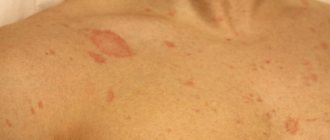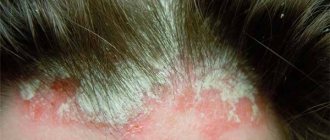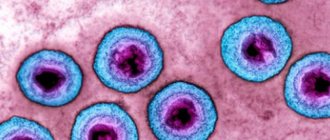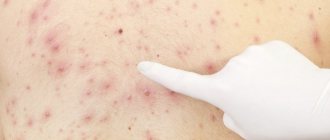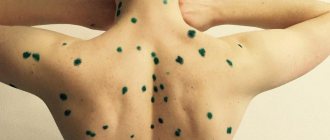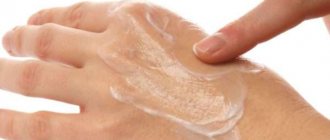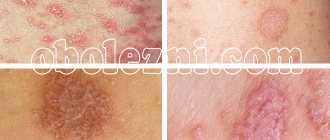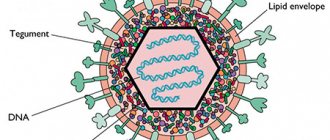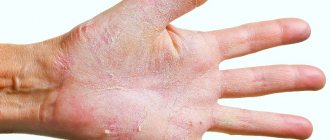After infection, the incubation period begins for lichen in humans. It is necessary to know how long it takes so that the disease does not reach an advanced stage. For certain types of lichen, the patient must be isolated during the incubation period. The source of infection is a fungus, but the likelihood of infection increases the likelihood of recent illnesses or the presence of chronic illnesses.
Types of lichen and their symptoms
For all types of lichen, a characteristic symptom is a violation of the normal pigmentation of the skin.
Pronounced spots with a color characteristic of a particular type of disease may appear on the body in different places.
As the disease progresses, the spots peel, crack, and in the area where the lichen is localized, skin tightness and itching are felt.
In medical practice, there are 5 main subtypes of the disease:
- ringworm - it is caused by a fungal infection of the genus dermatophytes and affects areas of the skin covered with hair;
- pityriasis versicolor - it is also called pityriasis versicolor because of the characteristic shade of spots protruding on the skin. The cause is yeast fungi. This type of lichen is not considered contagious;
- herpes zoster - the causative agent of this type is the herpes virus, and any spot that forms during the disease will be located along the nerve trunks;
- pityriasis rosea - this type of disease occurs with an inflammatory process, as it often occurs an hour or after an acute respiratory viral infection. And the question about the contagiousness of pityriasis rosea remains open to this day;
- lichen ruber - the nature of its occurrence is systemic autoimmune disorders in the body, therefore lichen ruber is not transmitted from person to person.
First manifestations in humans
General symptoms:
- Skin pigmentation disorder.
- The appearance of characteristic spots with a specific color.
- The surface of the spots begins to peel, crack, itch, and a feeling of tightness appears.
Symptoms of the disease according to the type of pathogen
| General criteria | Type of lichen | |||
| Pink | girdling | Pityriasis | Shearer | |
| Location of the lesion | Skin, Langer's folds | Along the line of nerve trunks | Skin and scalp | Skin under hair |
| General state | Possible slight weakness, fever | Fever, fatigue, headache. After the rash appears, intoxication occurs. | Develops rapidly against a background of weakened immunity | The temperature is normal, manifested by a rash |
| Spots and rash characteristic of the disease | A pink maternal spot appears, up to 5 cm in size. Then - small spots. | A rash appears along the nerve trunks. Over time it fills with liquid. | The rash is small and itchy. The shape of the rash is irregular, the edges are clearly defined. | Round or oval spots on the scalp |
| Additional symptoms | The patient is contagious from the moment of contact | Enlarged lymph nodes | Not contagious | At the site of formation, hair breaks off up to 1 cm |
Incubation period of lichen and routes of transmission
Pityriasis versicolor photo
There are several ways to transmit lichen:
- direct contact (touch) with the skin of a sick person;
- through household items (towels, combs, clothes) or in common areas (handrails, door handles, swimming pool, toys, etc.);
- through contact with the fur of an animal (cat, dog) that is a carrier of lichen (this is how the ringworm type of the disease is transmitted).
Of course, every person can “catch” lichen, but contact with an infected carrier or staying in places of greatest spread does not always lead to infection.
The immune system of a healthy person successfully copes with repelling the “attack” of fungal pathogens, in most cases.
But, if the immune system is weakened, a person suffers from chronic diseases or there is an infection in the body, then the risks of developing lichen on the skin increase several times, especially in children and older people.
It is necessary to know what the incubation period is for lichen if a person has had contact with a patient in order to monitor the symptoms of the disease and, if infected, begin treatment on time.
It is also necessary to understand whether lichen is contagious during the incubation period and whether a person who has had contact with an infected carrier of the fungus can continue his usual lifestyle - visiting public places, being in a group.
The incubation period for lichen in humans is, on average, 1-3 weeks after the fungus comes into contact with human skin.
Or, on the contrary, you need to try to isolate him for a certain period - we’ll try to figure it out.
How is lichen transmitted from person to person?
Many types of lichen are contagious and can be transmitted through contact with an infected person.
Infection most often occurs when particles of damaged skin enter healthy areas, due to which the virus begins to gradually progress and infect the epidermis.
Ringworm
Ringworm is caused by trichophytosis infection and tends to quickly spread to healthy areas of the skin. Most often it is transmitted through contact with animals, but as a result of human infection, transmission of the infection through contact is possible.
Most often, this type of disease manifests itself with the following symptoms:
- The appearance of plaques with the presence of bubbles, with unclear edges;
- When the hair part is damaged, the hair becomes damaged, which leads to bald patches;
- When scratching the formations, the disease moves to healthy areas of the skin;
Has the ability to be transmitted to other people using the following methods:
- During physical contact with a person, such as shaking hands;
- When using personal care items such as towels and combs;
- When using things of an infected person, such as hats;
- Upon contact with an animal with the presence of the lichen virus;
- During contact with pieces of furniture with which the animal was in contact;
- In public places, if there is damage to the skin.
Pityriasis rosea
Pityriasis rosea or Zhibert's pityriasis is a disease that very often appears without any symptoms. Medical specialists cannot say with certainty the causes of the disease.
Most often, ringworm appears as pink and brown patches that first appear in places such as the inner thighs and chest. Most often, the disease does not cause unpleasant symptoms and tends to disappear on its own.
Most often, the following reasons contribute to the appearance of lichen:
- Reduced immunity;
- Failure to maintain the required level of hand hygiene;
- Untimely treatment of internal organs;
- Heredity.
Many people who have a high level of excitability and experience frequent stressful situations are most likely to develop this type of disease.
Shingles
The appearance of such lichen is formed as a result of a viral infection, which manifests itself in the form of plaques on the skin with the presence of blisters. This type of infection mainly occurs in the area of the ribs and waist. People who have had chickenpox are most often affected.
This type of lichen is transmitted from person to person in the following ways:
- Upon contact with a person who is a carrier of the infection;
- When using clothing that was previously worn by a person infected with the virus;
- When using other people's personal hygiene products.
Pityriasis versicolor
Pityriasis versicolor or versicolor versicolor in humans occurs when the skin is damaged by pathogenic fungi, which, when they get on the skin, tend to multiply quickly and infect healthy skin cells.
This type of lichen manifests itself as plaques of various shapes from burgundy to brown. Most often appear in the abdomen and arms. If not treated correctly, this type of infection can last a long time, periodically exacerbating its symptoms.
The most common causes of the disease are:
- Diabetes mellitus;
- Exacerbation of diathesis;
- Tuberculosis;
- Reduced immunity;
- Disruption of the sweat glands, causing increased sweating;
- Using antibacterial products that are not suitable for your skin type.
Lichen planus
The appearance of this type of lichen is very often accompanied by a large number of unpleasant symptoms. This type of disease can be chronic and manifest only in cases of reduced immunity.
Most often this disease appears in the following areas of the body:
- On the bend of the elbows;
- Inner thighs;
- Lumbar groin area;
- Armpits.
The disease manifests itself in the form of red spots of various shapes. The causes of lichen may be related to nervous disorders and improper hygiene of the human body.
Ringworm
The occurrence of this type of lichen occurs due to a viral infection of the skin. This disease manifests itself in humans in the form of pink spots of various shapes, containing a kind of blisters that secrete a specific liquid.
This type of lichen tends to spread very quickly to healthy areas of human skin.
The reasons for the appearance of such deprivation are as follows:
- Malfunctions of the immune system;
- Frequent cases of hypothermia;
- Heredity;
- Prolonged stressful situations.
Ringworm tends to cause severe itching and burning in humans. Most often, this type of lichen appears on the hands, especially in the palm area.
The disease is contagious.
A person can become infected in the following ways:
- In close contact with an infected person;
- When using personal hygiene products of an infected person;
- By contact with objects touched by an infected person, for example, when using public transport;
- Upon contact with animals that are carriers of the disease.
Squamosal lichen
Lichen squamosus is a skin disease also called psoriasis. This disease appears on the skin in the form of red and pink plaques.
It can appear almost anywhere and progress depending on the degree of decrease in the protective functions of the immune system.
Most often, the disease manifests itself in the form of a small rash, which gradually increases in size; upon visual examination, peeling and cracking of the skin at the sites of infection may be observed.
When the disease worsens, special medications are prescribed that block further development and eliminate unpleasant symptoms.
This type of lichen occurs for the following reasons:
- Decreased immune system;
- Frequent hypothermia;
- Frequent stressful situations;
- Bad habits;
- Heredity.
Experts say that this type of disease appears most often in childhood and young adulthood.
Lichen squamosus can be transmitted from mother to child.
Solar lichen
This type of skin infection occurs in humans as a result of infection with fungi that destroy the skin surface and cause discomfort. Most often, such lichen appears in humans in the autumn and spring.
It is during this period that an infected person may experience the appearance of cinnamon and yellow spots without any inflammatory formations.
When infected, spots can grow on the body at a high rate. Most often they appear on the back, stomach, and legs. With this type of disease, tanning does not appear while in the sun.
The causes of the disease are the following factors:
- Experiencing frequent colds;
- Reduced immunity;
- Excess weight;
- Prolonged exposure to the sun.
Pityriasis alba
This type of lichen is manifested by the appearance of light spots on the skin, which contribute to itching and burning, especially after contact with water.
Most often, this type of lichen appears in a person’s face, shoulders and hips.
The disease very often appears between the ages of 3 and 30, after which it tends to disappear on its own.
The causes of such lichen are still unknown to medicine; there are a large number of different theories.
However, it has been noticed that this type of skin infection appears to a greater extent in males and after suffering from various viral diseases.
Tubular lichen
This type of lichen refers to infectious skin lesions. Most often appears at a young age.
The causes of occurrence include the following factors:
- Weakened immunity;
- Frequent hypothermia;
- Malfunctions of the sweat glands;
- Diseases of internal organs;
- Using items of poor quality;
- Stressful situations;
- Genetic predisposition.
Asbestos lichen
Lichen asbestos most often appears in areas where hair grows. Light spots appear on the scalp, which flake and cause discomfort.
In places where plaques form, you may notice inflammatory swelling and swelling of the skin.
The reasons for this deprivation are as follows:
- Decreased immunity;
- Disruption of the sebaceous glands of the head area.
In addition, the main symptoms are:
- Peeling has a slight grayish or silvery tint;
- The scales cover not only the inflamed skin of the lichen, but also the hair itself;
- The hairs do not break off, but they look lifeless and dull.
Lichen nodosum
Lichen nodosum is also called Piedra's lichen and appears as a result of skin infection with a viral infection.
It appears in the form of nodules of various shapes on the hair shaft.
The most common reasons are the following:
- Incorrectly selected hats;
- Hot climate;
- Stressful situations.
This type of lichen most often appears in hot climates and tends to be transmitted to other people as follows:
- When using someone else's combs;
- Using hats of infected people;
- Skin contact.
Feline ringworm
Feline ringworm is a fungal type of skin disease that can be transmitted from a sick person to a healthy person. This type of infection is transmitted to humans from pets, such as cats, and quickly spreads throughout the body.
Most often, homeless animals are exposed to this type of disease, and they infect pets through contact.
In humans, lichen manifests itself with the following symptoms:
- The appearance of pink formations with peeling edges; crusts and blisters may be observed in the middle of the spot;
- The formation is accompanied by severe itching and burning;
- When lichen appears in the scalp area, hair damage and complete removal occur;
- The disease tends to quickly spread throughout the body.
A person can become infected in the following ways:
- In contact with stray animals;
- In the absence of control over the place where pets are walked;
- From a sick person to a healthy person upon contact;
- When using personal hygiene items of an infected person;
- In public places.
Incubation period of ringworm
Infected animals are carriers of fungi of the genus Microsporum and Trichophytum (ringworm).
Ringworm in a child photo
The most common type of transmission of lichen to humans occurs from a cat, less often from a dog or other animal.
If the animal has long hair, then it is difficult to notice the disease immediately when it occurs.
Therefore, you should regularly examine your pets if they are walking on the street, and also avoid contact with stray cats and dogs, especially for children.
The incubation period for ringworm in a person infected directly from an animal is 5-7 days.
Whereas, the incubation period of ringworm in children and adults when infected from a person whose skin is affected has a longer period - from one week to a month.
Ringworm may not reveal itself in any way during the incubation period, but you should carefully monitor the skin, especially carefully, examining the root area of the head and, at the first signs, consult a specialist.
An advanced form of microsporia in children requires serious treatment in a hospital setting.
Red (flat)
The etiology of this type of lichen has not been fully studied, but most experts believe that the cause of the development of lichen ruber is the patient’s predisposition to allergic reactions, and secondarily viral infections.
Lichen ruber is characterized by the appearance of small, red or purple nodules with clear borders on the skin. The incubation period can be 14 days from the moment of infection with lichen.
Incubation period of herpes zoster
This subtype of the disease manifests itself more often in old age or in children after 10 years of age, who have passed the common childhood disease - chicken pox.
Herpes zoster photo
The disease has similar symptoms - in place of the pink spots that appear on the first day of the disease, bubbles with liquid form.
Their arrangement occurs linearly.
Lymph nodes also enlarge and the temperature rises, which indicates an inflammatory process.
The incubation period for shingles lasts from 2 days to one month.
The timing, number and duration of rashes are determined. The protruding blisters quickly burst, and the serous fluid turns into crusts.
During this time, the person is contagious and must therefore remain in isolation. But at the same time, treatment can be carried out at home, provided that the disease is not complicated.
What kind of disease is lichen?
Ringworm is a skin type of disease that is viral in nature and affects epidermal cells. With this type of skin disease, a person experiences inflammatory processes on the skin, resulting in swelling and flaking of the skin.
Lesions can appear as single or multiple lesions, affecting the entire area of the body; the degree of spread of lichen is most often associated with its type.
Otherwise, a person may experience an increase in formations, which will complicate treatment and take a long time.
Incubation period of pityriasis rosea
Pityriasis rosea photo
There is still debate about whether pityriasis rosea is contagious or not. Since cases of this type of infection have been recorded, entire families have been affected.
But it has not been possible to establish for certain which pathogen causes the manifestation of pityriasis rosea.
At the same time, there is a version that the transmission route for this disease is lice, bedbugs, and personal hygiene items.
The incubation period for pityriasis rosea in humans can range from 2 days to 21.
During the incubation period, lichen in adults and children manifests itself in the same way:
Symptoms of pityriasis rosea
- an oval spot of bright pink color forms on the skin (maternal plaque);
- later, around the main spot, others, smaller ones, form;
- the skin in these places begins to peel, itch, tighten and crack.
Pityriasis rosea is localized in areas of increased sweating - under the arms, in the groin, under the breasts, on the thighs.
Treatment for pityriasis rosea is long-term – up to two months. But there is no secondary damage - a person develops immunity to this type of infection for the rest of his life.
Pityriasis
This disease is of a fungal nature. The main areas affected by lichen are the areas of nerve endings. As a rule, pityriasis versicolor manifests itself after stressful situations, in old age and when the immune system is weakened.
The incubation period can reach 2-3 weeks. It is typical that the patient does not feel a deterioration in his general condition. At the end of the latent period, plaques of brown, pink or yellow color appear on the patient’s skin. The length of the incubation period depends on the general condition of the patient's immune system. With a weakened immune system, the first manifestations may occur after 2-3 days.
Prevention measures for deprivation
If a carrier of any form of lichen appears in the house, then increased preventive measures must be observed:
- Avoid touching the patient’s skin as much as possible;
- an infected person must have separate household items - towels, bed linen, dishes, etc.;
- textile accessories should be washed at high temperatures, and other household items should be disinfected;
- other family members are recommended to take medications that support immunity.
In general, you can protect yourself from infection if you adhere to basic hygiene rules:
- after being outside and/or in public places, wash your hands;
- lead a healthy lifestyle;
- do not swim in polluted waters;
- do not pet homeless animals;
- wear clothes that do not sweat the skin and do not provoke excessive sweating;
- use only personal hygiene products.
